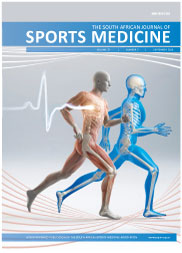Ultrasound v. sham ultrasound for experimentally induced delayed-onset muscle soreness: A double-blind, randomised controlled trial
DOI:
https://doi.org/10.7196/SAJSM.535Abstract
Background. Therapeutic ultrasound (US) is an electrophysical therapy that is commonly used by sports physiotherapists, but its mechanism
of action is unclear. There is little evidence that US therapy is more effective than sham US therapy, and any clinical benefits may be due
to a placebo effect.
Objective. To investigate whether US has a specific effect that renders it effective in its own right, or whether its effect is placebo driven.
Methods. In a double-blind controlled trial, delayed-onset muscle soreness (DOMS) was experimentally induced in both bicep muscles
of 15 females. Sham US was applied to one bicep (n=15 biceps) and pulsed active US to the other bicep (n=15 biceps) of each participant,
48 and 72 h after induction of DOMS. Primary and secondary outcomes were pain reported on the McGill Pain Questionnaire (MPQ) and
range of movement (ROM) (elbow extension) measured by goniometry, respectively.
Results. Results showed significant improvements in pain and ROM over the intervention periods, but there was no difference between
interventions.
Conclusion. US and sham US therapy improve pain equally when treating DOMS of the biceps in the context of a therapeutic encounter.
This analgesic effect is placebo driven. Clinicians can influence the analgesic effect of US by managing the therapeutic context. Management
of patients’ anxiety may also boost the analgesic effect of US.
Downloads
Downloads
Published
Issue
Section
License
Copyright (c) 2014 South African Journal of Sports Medicine

This work is licensed under a Creative Commons Attribution 4.0 International License.
The South African Journal of Sports Medicine reserves copyright of the material published. The work is licensed under a Creative Commons Attribution 4.0 (CC BY 4.0) International License. Material submitted for publication in the South African Journal of Sports Medicine is accepted provided it has not been published elsewhere. The South African Journal of Sports Medicine does not hold itself responsible for statements made by the authors.
How to Cite
- Abstract 482
- PDF 528





.png)